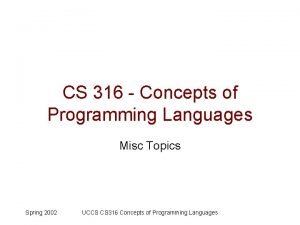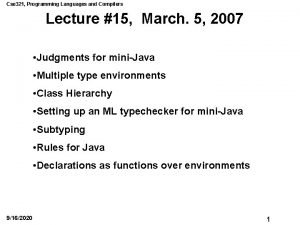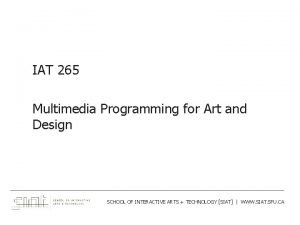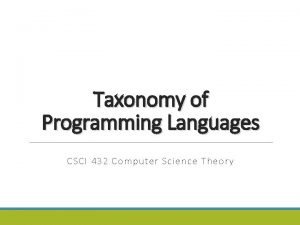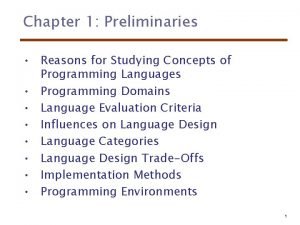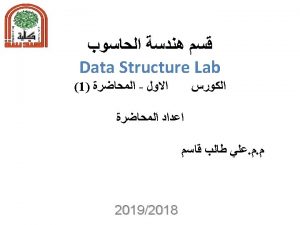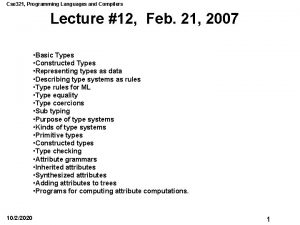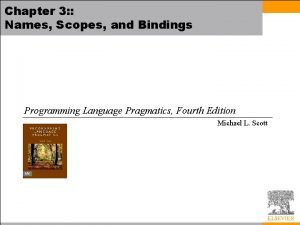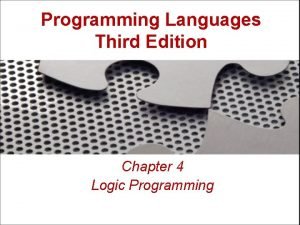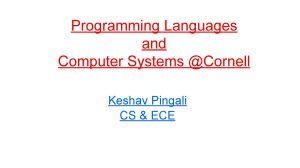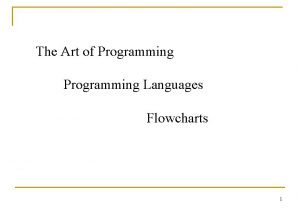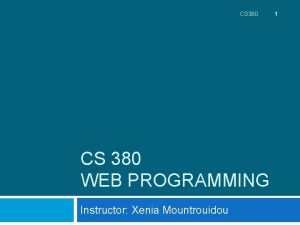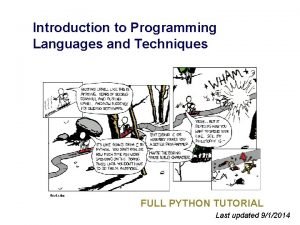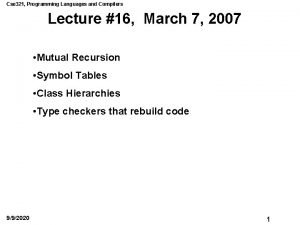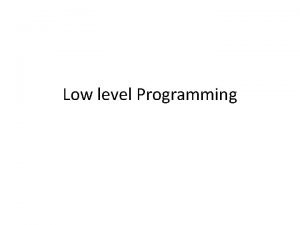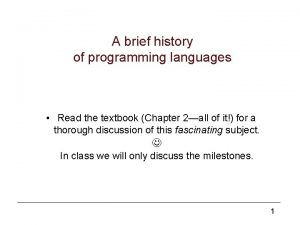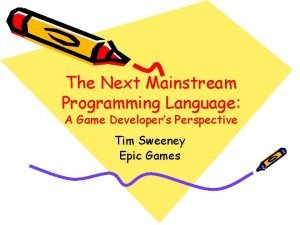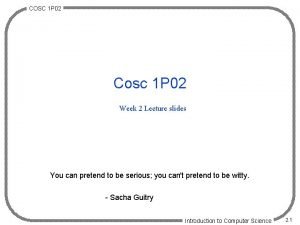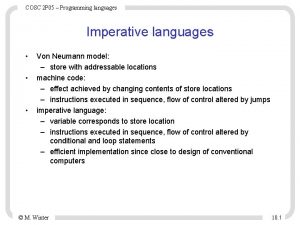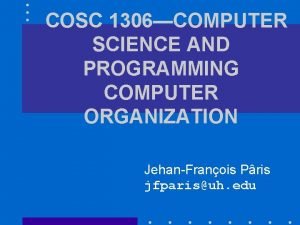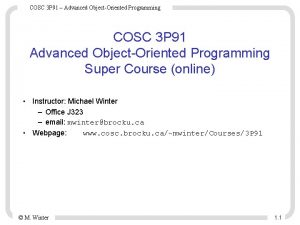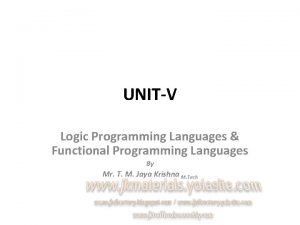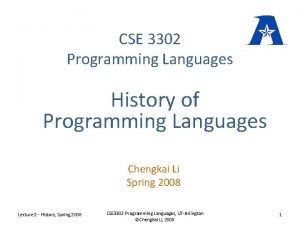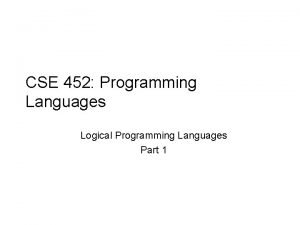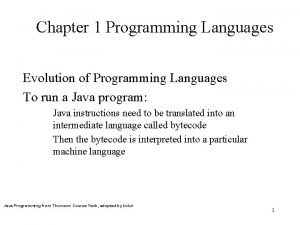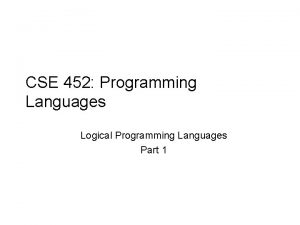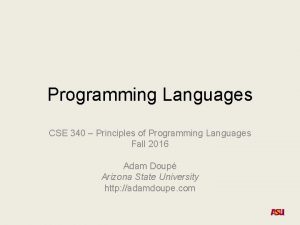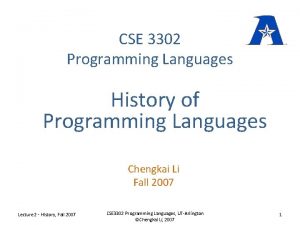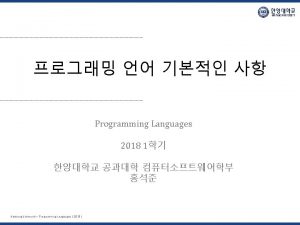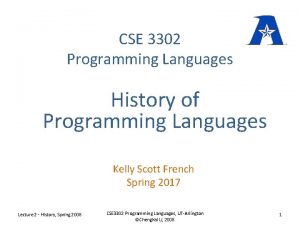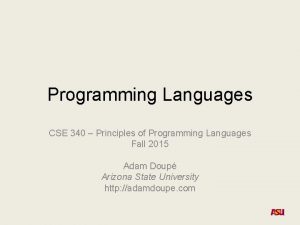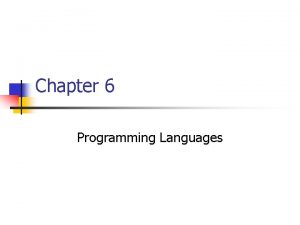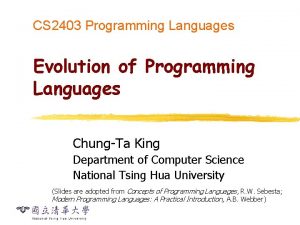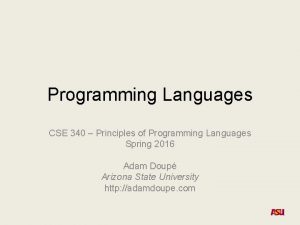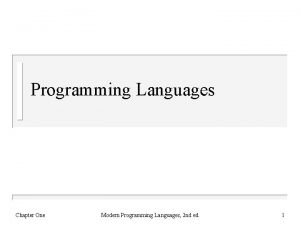COSC 2 P 05 Programming languages COSC 2









































- Slides: 41

COSC 2 P 05 – Programming languages COSC 2 P 05 Programming Languages • • Instructor: – Michael Winter – Office: MCC J 323 – Email: mwinter@brocku. ca Lecture: Mon & Thu, 14: 00 -15: 30 online in Lifesize Course web page: www. cosc. brocku. ca/~mwinter/Courses/2 P 05/ Textbook: Sebesta, Robert W. Concepts of Programming Languages (12 th edition) Pearson, 2019 ISBN: 9780135102268 © M. Winter 1. 1

COSC 2 P 05 – Programming languages Course Work • Marking Scheme – Midterm 1 – Midterm 2 – Final Exam Feb 11, 14: 00 -15: 30 Mar 18, 14: 00 -15: 30 Apr 12, 13: 00 -15: 00 20% 60% Both tests and the final exam will be online in Lifesize during the regular lecture time. © M. Winter 1. 2

COSC 2 P 05 – Programming languages Course Outline Week Date Chapter Topic 1 Jan 11/14 1, 2 Introduction, Evolution of programming languages 2 Jan 18/21 2 Evolution of programming languages 3 Jan 25/28 5, 6 Names, Bindings, Scope, Data types 4 Feb 01/04 6, 7 Data types, Expressions and assignments 5 Feb 08/11 8 Control structures (Midterm 1) 6* Feb 22/25 9, 10 Subprograms 7 Mar 01/04 11 Abstract data type 8 Mar 08/11 12 Object-oriented languages 9 Mar 15/18 13 Concurrency (Midterm 2) 10 Mar 22/25 15 Functional programming languages 11 Mar 29/Apr 01 15, 16 Functional programming languages, Logic programming languages 12 Apr 05/08 16 Logic programming languages, Review * Feb 15 -19 is Reading Week. © M. Winter 1. 3

COSC 2 P 05 – Programming languages Why Studying Programming Languages • • • Increased capacity to express ideas – Implementation of concepts learnt in another language that is not available in the given language Improve background for choosing appropriate language – Knowing only one or two languages leads to using these languages even for problems they are poorly suited for Increased ability to learn new languages – Knowing the fundamental concepts of programming languages makes it easy to learn new languages Better understanding of the significance of implementation – Understanding concepts and their implementation allows using the language more intelligently; certain bugs can only be found if certain implementation details are known Better use of languages that are already known – Knowing fundamental concepts may lead to use previously unknown (or unused) feature of a language Overall advancement of computing – Better understanding of programming languages in the community leads to better lanaguages © M. Winter 1. 4

COSC 2 P 05 – Programming languages Programming Domains • • • Scientific applications – Main domain in the early days of computing (FORTAN) Business applications – Facilities needed: Reports, Various (precise) decimal numbers and operations, character data (COBOL) Artificial Intelligence – Symbolic computation and lists (LISP) System programming – Low-level features (PL I, C) Web software – Dynamic web content, scripting (Java. Script, PHP) © M. Winter 1. 5

COSC 2 P 05 – Programming languages Language Evaluation Criteria • • • Readability – How easy is it to understand a given program? – Early languages focused on machine readability rather than programmer readability – Important for maintenance and extension – Has to be considered in the context of the problem domain Writability – How easy is it to write a program for a chosen problem? – Has to be considered in the context of the problem domain Reliability – A program is reliable if it performs to its specification under all conditions – Program correctness © M. Winter 1. 6

COSC 2 P 05 – Programming languages Language Evaluation Criteria © M. Winter 1. 7

COSC 2 P 05 – Programming languages Readability • • Simplicity – A language with a large number of basic constructs is more difficult to learn – Feature multiplicity – Operator overloading – Simplicity vs. high-level language Orthogonality – Small number of primitive constructs can be combined in a small number of ways, each combination is legal and meaningful – Independent of context Data types – Adequate data types are available, e. g. , Booleans Syntax Design – Identifier forms, special words, form and meaning © M. Winter 1. 8

COSC 2 P 05 – Programming languages Writability • • • Simplicity – Misuse of unknown features Orthogonality – Low orthogonality requires to memorize a lot of exceptions – Errors can go undetected if nearly all combinations of primitives are legal Data types and Syntax design – See Readability Support for abstraction – Ability to define and use structures in ways that allow many details to be ignored – Process abstraction: subprograms, polymorphism – Data abstraction: interfaces, references, recursive data types Expressivity – Powerful but convenient constructions © M. Winter 1. 9

COSC 2 P 05 – Programming languages Reliability • • Simplicity, Orthogonality, Data types, Syntax design, Support for abstraction and Expressivity – See Readability and/or Writability Type checking – Simple test for type errors – Compile-time: more desirable, detect before run – Errors at run-time: costly and errors might not be detected Exception handling – Intercept run-time errors Aliasing – Two or more distinct names accessing the same memory cell – Dangerous feature © M. Winter 1. 10

COSC 2 P 05 – Programming languages Influences on Language Design • Computer Architecture • Program Design Methodologies – Top-down design and stepwise refinement – Procedure-oriented vs. data-oriented Language Categories – Imperative languages – Object-oriented languages – Visual languages – Logic programming languages – Functional programming languages • © M. Winter 1. 11

COSC 2 P 05 – Programming languages Implementation Methods • • • © M. Winter Compilation Interpretation Hybrid System 1. 12

COSC 2 P 05 – Programming languages Compilation © M. Winter 1. 13

COSC 2 P 05 – Programming languages Pure Interpretation © M. Winter 1. 14

COSC 2 P 05 – Programming languages Hybrid Systems © M. Winter 1. 15

COSC 2 P 05 – Programming languages Evolution of Programming Languages Zuse’s Plankalkül • Developed in 1943 -45 as part of his Ph. D • First published in 1972 • Data types: bit, integer, floating-point type, arrays, records • For and while loops, no goto • Includes assertions, i. e. , mathematical expressions that would be true during execution at the point in the code • Two-dimensional syntax | A + 1 => A V | 4 5 S | 1. n © M. Winter 1. 16

COSC 2 P 05 – Programming languages © M. Winter 1. 17

COSC 2 P 05 – Programming languages FORTRAN • • FORmula TRANslating system First generally available heigh-level language Goals – Reduce development & debugging costs – Efficient compilation Features – Comments – No data-typing statements (implicit type convention) – Mathematical notation – Looping statement (DO) – Subroutines & functions – I/O formatting – Machine independence • but no standard © M. Winter 1. 18

COSC 2 P 05 – Programming languages • • Reasons for success of FORTRAN – Easy to learn compared to assembly language/machine code – Supported by IBM – Most users and applications at the time were scientific – Simplified tedious tasks, e. g. I/O FORTRAN IV, 77, 90, 95, 2003, 2008, 2018 – Type declarations for variables – If construct – Subprograms as parameters – Dynamic arrays, pointers – Modules – Support for object-orientation © M. Winter 1. 19

COSC 2 P 05 – Programming languages FORTRAN Program C FORTRAN PROGRAM TO FIND MEAN OF N NUMBERS AND C NUMBER OF VALUES GREATER THAN THE MEAN DIMENSION A(99) REAL MEAN READ(1, 5) N 5 FORMAT(I 2) READ(1, 10)(A(I), I=1, N) 10 FORMAT(6 F 10. 5) SUM=0. 0 DO 15 I=1, N 15 SUM=SUM+A(I) MEAN=SUM/FLOAT(N) NUMBER=0 DO 20 I=1, N IF (A(I). LE. MEAN) GOTO 20 NUMBER=NUMBER+1 20 CONTINUE WRITE(2, 25) MEAN, NUMBER 25 FORMAT(8 H MEAN = , F 10. 5, 5 X, 20 H NUMBER OVER MEAN = , I 5) STOP END © M. Winter 1. 20

COSC 2 P 05 – Programming languages Fortran 95 Program ! Fortran 95 Example program ! Input: An integer, List_Len, where List_Len is less ! than 100, followed by List_Len-Integer values ! Output: The number of input values that are greater ! than the average of all input values Implicit none Integer Dimension(99) : : Int_List Integer : : List_Len, Counter, Sum, Average, Result= 0 Sum = 0 Read *, List_Len If ((List_Len > 0). AND. (List_Len < 100)) Then ! Read input data into an array and compute its sum Do Counter = 1, List_Len Read *, Int_List(Counter) Sum = Sum + Int_List(Counter) End Do © M. Winter 1. 21

COSC 2 P 05 – Programming languages ! Compute the average Average = Sum / List_Len ! Count the values that are greater than the average Do Counter = 1, List_Len If (Int_List(Counter) > Average) Then Result = Result + 1 End If End Do ! Print the result Print *, 'Number of values > Average is: ', Result Else Print *, 'Error - list length value is not legal' End If End Program Example © M. Winter 1. 22

COSC 2 P 05 – Programming languages BASIC • • • BASIC (Beginner’s All Purpose Symbolic Instruction Code) Designed as a language for liberal arts students in 1963, based on FORTRAN Goals – Easy to learn for nonscience students – “Pleasant and friendly” – Fast turnaround for homework (Timesharing systems) – Allow free and private access – Consider user time more important than computer time Features – Very small language – No input during run-time possible (batch-oriented) Later versions: Visual BASIC © M. Winter 1. 23

COSC 2 P 05 – Programming languages A BASIC Program REM Basic Example Program REM Input: An integer, listlen, where listlen is less REM than 100, followed by listlen-integer values REM Output: The number of input values that are greater REM than the average of all input values DIM intlist(99) result = 0 sum = 0 INPUT listlen IF listlen > 0 AND listlen < 100 THEN REM Read input into an array and compute the sum FOR counter = 1 TO listlen INPUT intlist(counter) sum = sum + intlist(counter) NEXT counter REM Compute the average = sum / listlen REM Count the number of input values that are > average © M. Winter 1. 24

COSC 2 P 05 – Programming languages FOR counter = 1 TO listlen IF intlist(counter) > average THEN result = result + 1 NEXT counter REM Print the result PRINT "The number of values that are > average is: "; result ELSE PRINT "Error-input list length is not legal" END IF END © M. Winter 1. 25

COSC 2 P 05 – Programming languages Lisp • • • Developed for AI applications in 1958 Two kinds of data structures: atoms and lists Atoms have the form of an identifier or a numeric literal Functional programming language List example: (A B C D) © M. Winter 1. 26

COSC 2 P 05 – Programming languages Lisp Program ; Lisp Example function ; The following code defines a Lisp predicate function ; that takes two lists as arguments and returns True ; if the two lists are equal, and NIL (false) otherwise (DEFUN equal_lists (lis 1 lis 2) (COND ((ATOM lis 1) (EQ lis 1 lis 2)) ((ATOM lis 2) NIL) ((equal_lists (CAR lis 1) (CAR lis 2)) (equal_lists (CDR lis 1) (CDR lis 2))) (T NIL) ) ) © M. Winter 1. 27

COSC 2 P 05 – Programming languages Related Languages • • Scheme – Developed in the mid-1970 s – Static scope – Functions are fully treated as first-class entities COMMON LISP – Created to incorporate several Lisp dialects into one common language – Allows static and dynamic scope – Large number of data types ML – Functional programming language that also allows imperative programming Haskell – Lazy evaluation – Use of monads © M. Winter 1. 28

COSC 2 P 05 – Programming languages ALGOL 60 • • • ALGOrithmic Language Joint European-US Committee (GAMM and ACM) Goals – Standard mathematical notation – Use to describe computing processes – Machine translatable ALGOL 58 report – BNF Features – Formal language definition – Block structure – Two different means of passing parameters (pass by value/name) – Arrays with variable bounds – Structured control statements – Recursion © M. Winter 1. 29

COSC 2 P 05 – Programming languages • • • Very successful in Europe Became the only acceptable formal means of communicating algorithms Reasons not widely used in North America – 3 years after FORTRAN – More features, harder to learn – Compilation too complex for the time, less efficient – No standard I/O © M. Winter 1. 30

COSC 2 P 05 – Programming languages An ALGOL 60 Program comment ALGOL 60 Example Program Input: An integer, listlen, where listlen is less than 100, followed by listlen-integer values Output: The number of input values that are greater than the average of all the input values ; begin integer array intlist [1: 99]; integer listlen, counter, sum, average, result; sum : = 0; result : = 0; readint (listlen); if (listlen > 0) ^ (listlen < 100) then begin comment Read input into an array and compute the average; © M. Winter 1. 31

COSC 2 P 05 – Programming languages for counter : = 1 step 1 until listlen do begin readint (intlist[counter]); sum : = sum + intlist[counter] end; comment Compute the average; average : = sum / listlen; comment Count the input values that are > average; for counter : = 1 step 1 until listlen do if intlist[counter] > average then result : = result + 1; comment Print result; printstring("The number of values > average is: "); printint (result) end else printstring ("Error-input list length is not legal"; end © M. Winter 1. 32

COSC 2 P 05 – Programming languages The Algol Family • • ALGOL W – Tidied up ALGOL 60 – Introduced • Records and references (linked structures) • Case statement • Multiple looping structures • Parameter passing: call-by-value, call-by-result, call-byvalue/result, call-by-name • String support • Assert statement Algol 68 – IFIP working group – Highly orthogonal – Highly-formal specification © M. Winter 1. 33

COSC 2 P 05 – Programming languages Pascal • • • Built on ALGOL W Goals – Efficient implementation – For teaching good programming style Widely used in universities and became common in industry Features – Restrictions on goto’s – User-defined data types – Strings Lacking features – No modules – Array parameters cannot be of variable length © M. Winter 1. 34

COSC 2 P 05 – Programming languages A Pascal Program {Pascal Example Program Input: An integer, listlen, where listlen is less than 100, followed by listlen-integer values Output: The number of input values that are greater than the average of all input values } program pasex (input, output); type intlisttype = array [1. . 99] of integer; var intlist : intlisttype; listlen, counter, sum, average, result : integer; begin result : = 0; sum : = 0; readln (listlen); if ((listlen > 0) and (listlen < 100)) then begin { Read input into an array and compute the sum } © M. Winter 1. 35

COSC 2 P 05 – Programming languages for counter : = 1 to listlen do begin readln (intlist[counter]); sum : = sum + intlist[counter] end; { Compute the average } average : = sum / listlen; { Count the number of input values that are > average } for counter : = 1 to listlen do if (intlist[counter] > average) then result : = result + 1; { Print the result } writeln ('The number of values > average is: ', result) end { of then clause of if (( listlen > 0. . . } else writeln ('Error-input list length is not legal’) end. © M. Winter 1. 36

COSC 2 P 05 – Programming languages COBOL • • COmmon Business Oriented Language Probably the most used programming language Based on FLOW-MATIC by UNIVAC Business data processing Usage of English as a programming language Features – English-like syntax – Emphasis on file processing; records – 4 divisions: identification, environment, data, procedure Mandated by the Do. D Tight language control – Relatively unchanged in 25 yearrs © M. Winter 1. 37

COSC 2 P 05 – Programming languages A COBOL Program IDENTIFICATION DIVISION. PROGRAM-ID. PRODUCE-REORDER-LISTING. ENVIRONMENT DIVISION. CONFIGURATION SECTION. SOURCE-COMPUTER. DEC-VAX. OBJECT-COMPUTER. DEC-VAX. INPUT-OUTPUT SECTION. FILE-CONTROL. SELECT BAL-FWD-FILE ASSIGN TO READER. SELECT REORDER-LISTING ASSIGN TO LOCAL-PRINTER. DATA DIVISION. FILE SECTION. FD BAL-FWD-FILE LABEL RECORDS ARE STANDARD RECORD CONTAINS 80 CHARACTERS. © M. Winter 1. 38

COSC 2 P 05 – Programming languages 01 BAL-FWD-CARD. 02 BAL-ITEM-NO PICTURE IS 9(5). 02 BAL-ITEM-DESC PICTURE IS X(20). 02 FILLER PICTURE IS X(5). 02 BAL-UNIT-PRICE PICTURE IS 999 V 99. 02 BAL-REORDER-POINT PICTURE IS 9(5). 02 BAL-ON-HAND PICTURE IS 9(5). 02 BAL-ON-ORDER PICTURE IS 9(5). 02 FILLER PICTURE IS X(30). FD REORDER-LISTING LABEL RECORDS ARE STANDARD RECORD CONTAINS 132 CHARACTERS. 01 REORDER-LINE. 02 RL-ITEM-NO PICTURE IS Z(5). 02 FILLER PICTURE IS X(5). 02 RL-ITEM-DESC PICTURE IS X(20). 02 FILLER PICTURE IS X(5). 02 RL-UNIT-PRICE PICTURE IS ZZZ. 99. 02 FILLER PICTURE IS X(5). 02 RL-AVAILABLE-STOCK PICTURE IS Z(5). 02 FILLER PICTURE IS X(5). 02 RL-REORDER-POINT PICTURE IS Z(5). 02 FILLER PICTURE IS X(71). © M. Winter 1. 39

COSC 2 P 05 – Programming languages WORKING-STORAGE SECTION. 01 SWITCHES. 02 CARD-EOF-SWITCH PICTURE IS X. 01 WORK-FIELDS. 02 AVAILABLE-STOCK PICTURE IS 9(5). PROCEDURE DIVISION. 000 -PRODUCE-REORDER-LISTING. OPEN INPUT BAL-FWD-FILE. OPEN OUTPUT REORDER-LISTING. MOVE "N" TO CARD-EOF-SWITCH. PERFORM 100 -PRODUCE-REORDER-LINE UNTIL CARD-EOF-SWITCH IS EQUAL TO "Y". CLOSE BAL-FWD-File. CLOSE REORDER-LISTING. STOP RUN. 100 -PRODUCE-REORDER-LINE. PERFORM 110 -READ-INVENTORY-RECORD. IF CARD-EOF-SWITCH IS NOT EQUAL TO "Y" PERFORM 120 -CALCULATE-AVAILABLE-STOCK IF AVAILABLE-STOCK IS LESS THAN BAL-REORDER-POINT PERFORM 130 -PRINT-REORDER-LINE. © M. Winter 1. 40

COSC 2 P 05 – Programming languages 110 -READ-INVENTORY-RECORD. READ BAL-FWD-FILE RECORD AT END MOVE "Y" TO CARD-EOF-SWITCH. 120 -CALCULATE-AVAILABLE-STOCK. ADD BAL-ON-HAND BAL-ON-ORDER GIVING AVAILABLE-STOCK. 130 -PRINT-REORDER-LINE. MOVE SPACE TO REORDER-LINE. MOVE BAL-ITEM-NO TO RL-ITEM-NO. MOVE BAL-ITEM-DESC TO RL-ITEM-DESC. MOVE BAL-UNIT-PRICE TO RL-UNIT-PRICE. MOVE AVAILABLE-STOCK TO RL-AVAILABLE-STOCK. MOVE BAL-REORDER-POINT TO RL-REORDER-POINT. WRITE REORDER-LINE. © M. Winter 1. 41
 Advantages of application software
Advantages of application software If programming languages were cars
If programming languages were cars Imperative programming languages
Imperative programming languages Programming languages
Programming languages Real-time systems and programming languages
Real-time systems and programming languages Adam doupe cse 340
Adam doupe cse 340 Iat 265
Iat 265 Introduction to programming languages
Introduction to programming languages Lisp_q
Lisp_q Vineeth kashyap
Vineeth kashyap Reasons for studying concepts of programming languages
Reasons for studying concepts of programming languages Alternative programming languages
Alternative programming languages Middle level programming languages
Middle level programming languages Programming languages
Programming languages Cs 421 programming languages and compilers
Cs 421 programming languages and compilers Types of programming languages
Types of programming languages Storage management in programming languages
Storage management in programming languages Plc coding language
Plc coding language Real time programming language
Real time programming language Programing languages
Programing languages Cornell programming languages
Cornell programming languages Strongly typed vs weakly typed
Strongly typed vs weakly typed Programming languages flowchart
Programming languages flowchart Language
Language Multithreaded programming languages
Multithreaded programming languages Xenia programming languages
Xenia programming languages Xkcd programming languages comparison
Xkcd programming languages comparison Joey paquet
Joey paquet Programming languages
Programming languages Cs 421 uiuc
Cs 421 uiuc Low level programming languages
Low level programming languages Transmission programming languages
Transmission programming languages Brief history of programming languages
Brief history of programming languages Cxc it
Cxc it Mainstream programming languages
Mainstream programming languages Greedy programming vs dynamic programming
Greedy programming vs dynamic programming System programming definition
System programming definition Integer programming vs linear programming
Integer programming vs linear programming Perbedaan linear programming dan integer programming
Perbedaan linear programming dan integer programming Definisi integer
Definisi integer Cosc 3p94
Cosc 3p94 Cosc 1p02
Cosc 1p02

